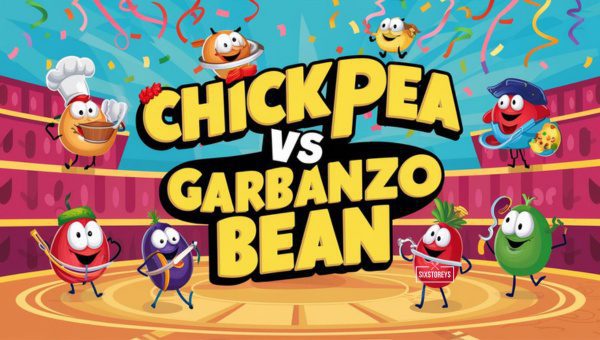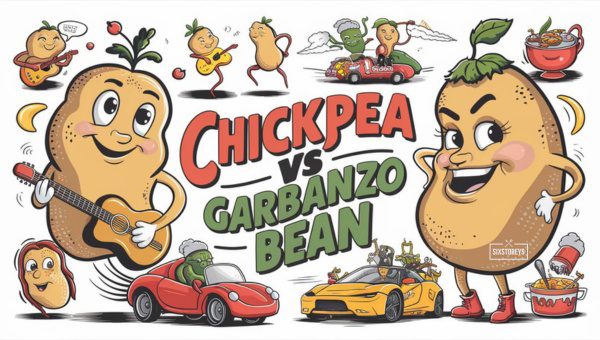Chickpea vs Garbanzo Bean: Which One Should You Eat?
Chickpea vs Garbanzo Bean: Are they truly different or just two names for the same legume? If you've ever wondered about this, you're not alone. In this post, we dive deep into the world of chickpeas and garbanzo beans, exploring their origins, nutritional benefits, and how they are used in various cuisines. We'll also bust some common myths and help you decide which one is the better choice for your diet. So, let's embark on this flavorful journey and uncover the truth behind chickpeas vs garbanzo beans!

Also Read: Naan vs. Pita Bread
Article Includes
Chickpea vs Garbanzo Bean — What’s the Difference?
If you've ever found yourself puzzled over whether chickpeas and garbanzo beans are the same thing, trust me, you're not alone. I used to think they were two different beans entirely—maybe distant relatives in the legume family. But the reality is much simpler: chickpea, Cicer arietinum, and garbanzo bean are just two names for the same thing.
To put it plainly, it comes down to language. The word "chickpea" has Latin roots, derived from the word cicer. On the other hand, "garbanzo" comes from Spanish, a term adopted into English in the 18th century. However, the bean itself is one and the same, packed with the same nutritional punch and versatile culinary uses.
Different Names, Same Bean
Though the names vary, what doesn’t change is the bean’s nutritious value and delicious versatility. Whether you call it a chickpea or a garbanzo bean, you're getting a bean that is:
- High in protein
- Packed with fiber
- Rich in essential vitamins and minerals
Culinary Versatility
In my kitchen, these beans are nothing short of magical. One day they’re the base for a creamy hummus, and the next they’re the star in a spicy chana masala. Here are some popular dishes you might know:
- Hummus
- Falafel
- Chickpea Stew
- Salads and Roasted Snacks
A Nutritional Powerhouse
Both chickpeas and garbanzo beans offer substantial health benefits. They can help with:
- Digestive health due to high fiber content
- Blood sugar control thanks to their low glycemic index
- Weight management because they are filling and protein-rich
Cooking Tips and Tricks
When it comes to using chickpeas or garbanzo beans in your kitchen, having a few handy tips can make all the difference. Here are some secrets I’ve picked up over the years:
Soaking and Boiling
If you’re working with dried chickpeas, it's essential to soak them overnight. This helps to soften them and reduce cooking time. Typically, I cover them with water and let them sit for at least 8 hours. Once they’re done soaking, rinse them thoroughly to remove any remaining anti-nutrients.
To boil, place the soaked beans in a large pot and cover with fresh water. Bring to a boil, then reduce the heat and let them simmer for about an hour or until they’re tender. Don’t add salt until the cooking is almost done, as salt can toughen the skin.
Getting the Perfect Texture
If you’re looking to achieve that creamy texture for dishes like hummus, I’ve found that adding a bit of baking soda to the boiling water helps break down the beans' skins. It's a small trick, but it makes a substantial difference.
Speedy Cooking with Canned Chickpeas
For those days when you’re short on time, canned chickpeas are a lifesaver. Just remember to rinse them well to remove any excess sodium and reduce the "canned" taste. You can toss them directly into salads, stews, or roast them for a crunchy snack.
Chickpeas in Global Cuisines
One aspect that makes chickpeas so fascinating is their versatility across various cuisines. Here's a culinary tour around the globe:
Middle Eastern Delight
In Middle Eastern cuisine, chickpeas are the star. Hummus is perhaps the most famous dish, where chickpeas are blended with tahini, garlic, lemon, and olive oil. Then there's falafel, those delicious deep-fried balls made from ground chickpeas, herbs, and spices.
Indian Favorites
Indian meals often feature chickpeas, known locally as chana. Chana Masala, for instance, is a spicy, tangy dish of chickpeas cooked with tomatoes, onions, and a host of aromatic spices.
Mediterranean Magic
In the Mediterranean, chickpeas often appear in soups and stews. They are tossed into fresh salads or paired with vegetables and grains.
Latin American Inclusion
You’ll also find chickpeas in Latin American cuisine. They’re often added to stews or served alongside rice and beans for a hearty meal.
Purchasing Chickpeas: Canned vs. Dried

Canned Chickpeas
Pros:
- Convenient and ready to use.
- Excellent for quick meals.
Cons:
- Often contain added sodium and preservatives.
- Can be pricier per serving compared to dried beans.
Dried Chickpeas
Pros:
- More cost-effective.
- Allows better control over texture and cooking process.
- Longer shelf life without preservatives.
Cons:
- Requires soaking and longer cooking times.
- Needs proper storage to prevent pests.
How to Choose
Your choice might boil down to convenience versus cost and control. For meal preppers and those who cook in bulk, dried chickpeas might be the best option. But if you’re always on the go, canned chickpeas can be a real time-saver.
Also Read: Gyoza vs. Dumplings
Fun Facts About Chickpeas/Garbanzo Beans
Who knew chickpeas could be so interesting? Here are a few fun facts:
- Two Types: Chickpeas come in two main varieties - Desi and Kabuli. Desi are smaller, darker, and more commonly found in India, while Kabuli are larger and lighter, more common in the Mediterranean and North America.
- Ancient Snack: Chickpeas have been cultivated for at least 7,000 years. They were a popular food in ancient Egypt and Greece.
- Versatile Flour: Chickpea flour, also known as gram flour or besan, is a staple in Indian cuisine. It’s gluten-free and fantastic for baking or as a batter for fritters.
- Protein Powerhouse: They are a fantastic source of plant-based protein, making them perfect for vegetarians and vegans.
- Space Chickpeas: In 2019, NASA sent chickpeas to the International Space Station to study how they grow in zero gravity!
Conclusion
So, there you have it. The next time you see a recipe or a menu item featuring chickpeas or garbanzo beans, you'll know they are simply different names for the same incredible legume. Feel free to use whichever name rolls off your tongue, but most importantly, make sure to enjoy their diverse and nutritious offerings. If you have favorite recipes or ways to use these beans, I’d love to hear them—drop a comment below!
